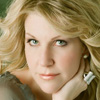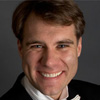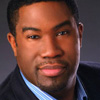skip to main |
skip to sidebar
Yesterday afternoon David and I and Peggy and Jim enjoyed the two Figaro Plays of Pierre Beaumarchais, translated, adapted and directed by Steven Wadsworth at McCarter Theatre at Princeton University. We were all familiar with the operas that used these plays as libretti, and it was interesting to see the original inspiration for them.
 Steve Wadsworth
The first, The Barber of Seville , was turned into an opera by Rossini. David and I had seen this performed at Chicago Lyric Opera this season in a rather tepid performance. The second, The Marriage of Figaro, was, of course, Mozart's take on the story.
The cast included Neal Bledsoe as Count Almaviva, Adam Green as Figaro,Naomi O'Connell as Rosine, Derek Smith as Dr. Bartolo, Burton Curtis as Engarde/Notary, Frank Corrado as LeBebe/Alcade, Jeanne Paulsen as Marceline, Cameron Folmar as Bazile, Cody Buege as Constable, and David Andrew Laws as Constable in The Barber of Seville. In the Marriage of Figaro, the same actors performed their same roles as they did in The Barber of Seville, plus Maggie Lacey as Suzanne, Betsy Hogg as Fanchette, Burton Curtis as Antonio, Cody Buege as Gripe-Soleil/Usher, David Andrew Laws as Pedrillo, Frank Corrado as Brid'oison, Larry Paulson as Doublehands, and Andrew Clark, Kimani Issac, Zoe Mann, Jean Prall Rosolino, and Katie Weinstein as members of the ensemble.
For anyone who knows the operas, the libretto was obviously abridged from the play to fit the music. The direction by Steve Wadsworth was imaginative and fun. He could have edited the second play which went on too long, especially a over-long monologue by Figaro towards the end.
The set by Charles Corcoran was serviceable and evocative. The costumes by Camille Assaf were charming with Spanish overtones.
The cast performed beautifully; a real ensemble effort. Both the Count and Rosine had very good singing voices.
Steve Wadsworth directed Lorraine in Ashoka's Dream, by Peter Lieberson and in Xerxes by Handel in Los Angeles, Boston and at New York City Center. He has the ability to keep the action moving with grace and eloquence. The second act of Marriage was too long and should have been cut.
I still prefer the operas.
Steve Wadsworth
The first, The Barber of Seville , was turned into an opera by Rossini. David and I had seen this performed at Chicago Lyric Opera this season in a rather tepid performance. The second, The Marriage of Figaro, was, of course, Mozart's take on the story.
The cast included Neal Bledsoe as Count Almaviva, Adam Green as Figaro,Naomi O'Connell as Rosine, Derek Smith as Dr. Bartolo, Burton Curtis as Engarde/Notary, Frank Corrado as LeBebe/Alcade, Jeanne Paulsen as Marceline, Cameron Folmar as Bazile, Cody Buege as Constable, and David Andrew Laws as Constable in The Barber of Seville. In the Marriage of Figaro, the same actors performed their same roles as they did in The Barber of Seville, plus Maggie Lacey as Suzanne, Betsy Hogg as Fanchette, Burton Curtis as Antonio, Cody Buege as Gripe-Soleil/Usher, David Andrew Laws as Pedrillo, Frank Corrado as Brid'oison, Larry Paulson as Doublehands, and Andrew Clark, Kimani Issac, Zoe Mann, Jean Prall Rosolino, and Katie Weinstein as members of the ensemble.
For anyone who knows the operas, the libretto was obviously abridged from the play to fit the music. The direction by Steve Wadsworth was imaginative and fun. He could have edited the second play which went on too long, especially a over-long monologue by Figaro towards the end.
The set by Charles Corcoran was serviceable and evocative. The costumes by Camille Assaf were charming with Spanish overtones.
The cast performed beautifully; a real ensemble effort. Both the Count and Rosine had very good singing voices.
Steve Wadsworth directed Lorraine in Ashoka's Dream, by Peter Lieberson and in Xerxes by Handel in Los Angeles, Boston and at New York City Center. He has the ability to keep the action moving with grace and eloquence. The second act of Marriage was too long and should have been cut.
I still prefer the operas.
 This afternoon Alice and I heard a very interesting concert presented by Crescendo, a choral group based in Lakeville, CT. It was conducted by Christine Gevert, who is also its founder. The concert was at Trinity Episcopal Church in Limerock.
The program alternated music by Ola Gjeilo, a Norwegian composer, and Jaime Soto Leon, a Chilean.
Ms. Gevert put together this program of music from two hemispheres. And the music indeed represented the ethnic differences between northern Euorpeans and South Americans.
Most of the Gjeilo works used a sort of plainchant or chorale idea with pedal points and rather traditional harmonies. The final work of this composer was the only one that expressed much rhythmic energy and the other works all had a great deal in common with each other. Flowing and melodic.
The Leon works, on the other hand were filled with rich South American rhythms and harmonies. If this were dance, I would compare the two styles to ballet and Flamenco. Cold and Hot.
Most of the Gjeilo pieces were a cappella, flowing works with occasional passages of chopped off chords against a viola solo. Nothing too different from other works of this contemporary period. Certainly all were tonal.
The Leon pieces were filled with rich harmonies and exotic rhythms. The wonderful musicians of the Andean Ensemble were Aurelio Dominguez, tenor, Jose Sacin, baritone, percussion, Carlos Boltes, charango, cuatro, ronroco, viola, voice, Scott Hill guitar, voice, Ernesto Bravo, tiple, percussion, zampona, voice, Gonzalo Cortes, quena, flute, voice, Fabio Mateus, quena, flute, voice, Roberto Claviho, zampona, percussion, voice, Rodrigo Tarraza, clarinet, saxophone, and Rudi Weeks, double bass, voice. Many of the instruments were typical of traditional Andean folk instruments, some going back to pre-Colombian times. They were played with great expertize and ardor.
This afternoon Alice and I heard a very interesting concert presented by Crescendo, a choral group based in Lakeville, CT. It was conducted by Christine Gevert, who is also its founder. The concert was at Trinity Episcopal Church in Limerock.
The program alternated music by Ola Gjeilo, a Norwegian composer, and Jaime Soto Leon, a Chilean.
Ms. Gevert put together this program of music from two hemispheres. And the music indeed represented the ethnic differences between northern Euorpeans and South Americans.
Most of the Gjeilo works used a sort of plainchant or chorale idea with pedal points and rather traditional harmonies. The final work of this composer was the only one that expressed much rhythmic energy and the other works all had a great deal in common with each other. Flowing and melodic.
The Leon works, on the other hand were filled with rich South American rhythms and harmonies. If this were dance, I would compare the two styles to ballet and Flamenco. Cold and Hot.
Most of the Gjeilo pieces were a cappella, flowing works with occasional passages of chopped off chords against a viola solo. Nothing too different from other works of this contemporary period. Certainly all were tonal.
The Leon pieces were filled with rich harmonies and exotic rhythms. The wonderful musicians of the Andean Ensemble were Aurelio Dominguez, tenor, Jose Sacin, baritone, percussion, Carlos Boltes, charango, cuatro, ronroco, viola, voice, Scott Hill guitar, voice, Ernesto Bravo, tiple, percussion, zampona, voice, Gonzalo Cortes, quena, flute, voice, Fabio Mateus, quena, flute, voice, Roberto Claviho, zampona, percussion, voice, Rodrigo Tarraza, clarinet, saxophone, and Rudi Weeks, double bass, voice. Many of the instruments were typical of traditional Andean folk instruments, some going back to pre-Colombian times. They were played with great expertize and ardor.
The bass and tenor soloists were amazing. They could step right into a Flamenco Tablao without taking a breath. They sang with fervor and great emotion.
When this group played and sang it was simply electrifying. The choral sound was, by comparison, rather bland. I have just returned from five months in Chicago, where I heard a number of excellent choral concerts. There is something about that mid-western choral sound that is magical. Maybe it's all the beef they eat!
Ms. Gevert gave a very succinct talk about the music beforehand and set the audience up for the concert. She tends to conduct with very large gestures except when conducting the instruments alone, when she cuts her movements back to size.
All in all it was a very interesting concert. I heard a lot of music I had never heard before and I enjoyed it.
I think Leon won!
This evening I heard my last Chicago concert until I return to the Windy City next Fall. Tomorrow I fly home to Rood Hill Farm to see how much winter snow is left.
And what a wonderful way to say arrivederci to Chicago and its musical scene. Tonight we heard a dynamic performance of Haydn's Creation conducted by the incredible Jane Glover. I humbly bow before her talent and wish I could see her conducting from the front as the chorus and orchestra does. From the back, her grace, precision, and musicality flow effortlessly into the voices and instruments under her baton. She simply lives the music and brings that inspiration to the group.
 The Creation is a marvelous work, filled with drama, joy, and even humor. Ms. Glover got every bit of those emotions out of her chorus and orchestra. With a minimum of motion she conveys mighty musical ideas.
The solo singers were Elizabeth Futral, soprano, Nicholas Phan, tenor, and Christopheren Nomura, baritone. They all have good voices but Mr. Phan was the only one whose diction could be understood. This was a shame, especially in Part III, which is mostly duets by Adam and Eve. Mr. Nomura could use a couple of low notes and Ms. Futral needs more centering in her middle and low voice. This would take care of the flutter. She often disappeared in the trios and some parts of the duets. The chorus was prepared by William Jon Gray and is wonderful.
The Creation is a marvelous work, filled with drama, joy, and even humor. Ms. Glover got every bit of those emotions out of her chorus and orchestra. With a minimum of motion she conveys mighty musical ideas.
The solo singers were Elizabeth Futral, soprano, Nicholas Phan, tenor, and Christopheren Nomura, baritone. They all have good voices but Mr. Phan was the only one whose diction could be understood. This was a shame, especially in Part III, which is mostly duets by Adam and Eve. Mr. Nomura could use a couple of low notes and Ms. Futral needs more centering in her middle and low voice. This would take care of the flutter. She often disappeared in the trios and some parts of the duets. The chorus was prepared by William Jon Gray and is wonderful.
I was interested to hear how different the sound of the chorus was both last fall in the St. John Passion and tonight under Ms. Glover's command, compared to the sounds they made under the man who conducted the December concert. It was in a different room, but the result was not good and the difference very apparent.
Ms. Glover apparently has magic hands!
Tonight Ms. Glover and the entire ensemble were perfection.
 The Blue Man Group is Marcel Marceau on steroids times three! David and I saw their performance this afternoon at the Briar Street Theatre in Chicago. The show is an endlessly energetic ballet of movement, sight gags, percussion and hilarity. It was a part of my birthday present from David and I feel well feted!!
None of the cast speaks a word throughout the hour and a half show but various screens send messages to the audience as the show progresses. The three men are expert percussionists, merrily banging away on various objects including plastic sewer pipes, a strange sort of xylophone, and anything else that comes in handy.
The various skits include getting members of the audience onstage, one of whom was clothed in a white jumpsuit, spray painted and hung by his heels. He was then swung at a white canvas producing an upside down painting of himself. He got to take it home with him.
At the finale, huge air balloons descended from on high, the three men blew rolls of toilet paper into the audience from wind machines, while strobe lights played on the whole scene. You had to be there.
And we were.
The Blue Man Group is Marcel Marceau on steroids times three! David and I saw their performance this afternoon at the Briar Street Theatre in Chicago. The show is an endlessly energetic ballet of movement, sight gags, percussion and hilarity. It was a part of my birthday present from David and I feel well feted!!
None of the cast speaks a word throughout the hour and a half show but various screens send messages to the audience as the show progresses. The three men are expert percussionists, merrily banging away on various objects including plastic sewer pipes, a strange sort of xylophone, and anything else that comes in handy.
The various skits include getting members of the audience onstage, one of whom was clothed in a white jumpsuit, spray painted and hung by his heels. He was then swung at a white canvas producing an upside down painting of himself. He got to take it home with him.
At the finale, huge air balloons descended from on high, the three men blew rolls of toilet paper into the audience from wind machines, while strobe lights played on the whole scene. You had to be there.
And we were.
 The Blue Man Group was created, written, and directed by Matt Goldman, Phil Stanton, and Chris Wink. Chris's late father Walter Wink, a renown theologian and speaker, was a resident of Sandisfield and a friend of mine. He even took some voice lessons from me some years ago. He certainly produced a creative son.
The Blue Man Group has been in action since 1987. It ran for 1000 performances in New York and now has companies performing in Boston, Chicago, Las Vegas, Orlando, Berlin, Amsterdam, and Oberhausen, as well as New York.
It should live forever!
PS Later we went to Giordano's for a fabulous pizza and salad. Perfect!
The Blue Man Group was created, written, and directed by Matt Goldman, Phil Stanton, and Chris Wink. Chris's late father Walter Wink, a renown theologian and speaker, was a resident of Sandisfield and a friend of mine. He even took some voice lessons from me some years ago. He certainly produced a creative son.
The Blue Man Group has been in action since 1987. It ran for 1000 performances in New York and now has companies performing in Boston, Chicago, Las Vegas, Orlando, Berlin, Amsterdam, and Oberhausen, as well as New York.
It should live forever!
PS Later we went to Giordano's for a fabulous pizza and salad. Perfect!
Chicago is apparently a hotbed of good choral singers and good choruses. This afternoon David and I heard the Chicago Chorale, under the direction of Bruce Tammen, perform a glorious program of music by Rheinberger, Brahms, Mendelssohn, and Bruckner in Rockefeller Chapel at Chicago University, just down the street from our condo.
 This choral group has a sweet and well-blended sound but can rise to the occasion when brilliant volume is needed.
The concert opened with Abendlied by Josef Rheinberger, a lovely work I had never heard. This was followed by Brahms's Es ist das Heil uns kommen her, and Mendelssohn's Herr, nun lassest du deinen Diener in Frieden fahren.
The last piece in the first half was Bruckner's sublime Os Justi. This is a work I used to perform with my choir at the Methodist Church in Red Bank, NJ in my days as a choir director and organist. It brought back fond memories.
The second half of the program was Bruckner's Mass in E Minor, a marvelous work which was also new to me. It was accompanied by an orchestra of clarinets, oboes, bassoons, horns, trumpets, and trombones. It is essentially an a capella piece with the instruments entering as choir voices, rather than the typical accompanied choral work. The result was magical.
Mr. Tammen certainly knows his choral stuff! Wonderful sound, musical interpretation, and beautiful accuracy. My one quibble would be several entrances that were a bit sloppy, but that is neither here nor there.
We were delighted to hear this marvelous program sung by this wonderful choir and played by these fine instrumentalists.
Bravi!
PS A police shoot out delayed the start of the concert and several of the musicians were late arriving. The suspect, a murderer, was captured at 9:00 p.m. last night.
This choral group has a sweet and well-blended sound but can rise to the occasion when brilliant volume is needed.
The concert opened with Abendlied by Josef Rheinberger, a lovely work I had never heard. This was followed by Brahms's Es ist das Heil uns kommen her, and Mendelssohn's Herr, nun lassest du deinen Diener in Frieden fahren.
The last piece in the first half was Bruckner's sublime Os Justi. This is a work I used to perform with my choir at the Methodist Church in Red Bank, NJ in my days as a choir director and organist. It brought back fond memories.
The second half of the program was Bruckner's Mass in E Minor, a marvelous work which was also new to me. It was accompanied by an orchestra of clarinets, oboes, bassoons, horns, trumpets, and trombones. It is essentially an a capella piece with the instruments entering as choir voices, rather than the typical accompanied choral work. The result was magical.
Mr. Tammen certainly knows his choral stuff! Wonderful sound, musical interpretation, and beautiful accuracy. My one quibble would be several entrances that were a bit sloppy, but that is neither here nor there.
We were delighted to hear this marvelous program sung by this wonderful choir and played by these fine instrumentalists.
Bravi!
PS A police shoot out delayed the start of the concert and several of the musicians were late arriving. The suspect, a murderer, was captured at 9:00 p.m. last night.
I must confess right at the start that I approach any production of Mozart's Clemenza di Tito with prejudice. Sesto was one of the roles for which Lorraine was most famous. I first met Lorraine Hunt (as she was then) Lieberson when she drove out from Boston to Rood Hill Farm many years ago for a first voice lesson. After chatting for a bit, she launched into 'Parto, parto' with all that glorious voice. I kept thinking, "What can I say to this woman. She is already in a busy career in Europe, she has this fabulous instrument,...."
When she had finished the aria, and I had told her how wonderful she sounded, I said "Do you realise that you are putting a large space between the consonant and the vowel in the first word? It's coming out as 'Puh-arto'. Try singing 'Parto', just like that.
She did, and we worked together for the next twenty years until her sad and much too early death in 2006. It was an amazing time for me.
So you see that I begin my listening of anything from a very high standard of beauty and excellence.
In tonight's performance of 'Tito', all of the singing was fairly good. No one sang flat or did anything strange. A couple of the sopranos had very fast vibrati but otherwise sang quite well.
 The Sesto of Joyce di Donato was well sung but in a voice lighter and higher than Lorraine's. At the opening of Act one, the three women all sounded much the same. Two mezzos and a soprano. No definition of voice or character. Ms. Donato also pulled back vocally for the very difficult runs. I mentioned this problem in the review I did of 'Barber' a while back. You don't need to pull the voice back to sing runs. You must move into the voice with energy and the runs will sing themselves. That's the way Lorraine did it and that is how I teach all of my students to sing.
The Sesto of Joyce di Donato was well sung but in a voice lighter and higher than Lorraine's. At the opening of Act one, the three women all sounded much the same. Two mezzos and a soprano. No definition of voice or character. Ms. Donato also pulled back vocally for the very difficult runs. I mentioned this problem in the review I did of 'Barber' a while back. You don't need to pull the voice back to sing runs. You must move into the voice with energy and the runs will sing themselves. That's the way Lorraine did it and that is how I teach all of my students to sing.
 I very much liked the Annio of Cecilia Hall and the Servilia of Emily Birsan.
I very much liked the Annio of Cecilia Hall and the Servilia of Emily Birsan.  I also liked the Publio of Christian van Horn and the Tito of Matthew Polenzani.
Poor Tito has a kind of dumb role to deal with. In fact, the entire libretto is fairly silly.Thank God for Mozart's magnificent music. I wonder what possessed him to set this to music?
The set by Sir David McVicar was stolid. An all-purpose back wall with windows and doors, an enormous clunky staircase that took up half the stage, and a few oddments that slid on and off stage.
The stage direction, like the set, was deathly heavy. It needed someone like Steve Wadsworth to get the people doing something besides standing still, facing out, and singing their piece. He directed Lorraine in Ashoka's Dream, and Xerxes, among other operas to tremendous effect.
I also liked the Publio of Christian van Horn and the Tito of Matthew Polenzani.
Poor Tito has a kind of dumb role to deal with. In fact, the entire libretto is fairly silly.Thank God for Mozart's magnificent music. I wonder what possessed him to set this to music?
The set by Sir David McVicar was stolid. An all-purpose back wall with windows and doors, an enormous clunky staircase that took up half the stage, and a few oddments that slid on and off stage.
The stage direction, like the set, was deathly heavy. It needed someone like Steve Wadsworth to get the people doing something besides standing still, facing out, and singing their piece. He directed Lorraine in Ashoka's Dream, and Xerxes, among other operas to tremendous effect.
As I said, the rest of the cast sang all right if you excuse the tremoli in some of the sopranos (soprani?). It was kind of a dull evening.
David and I amused ourselves by renaming two of the leading characters 'Vidalia and Pesto'. It works!
This evening David and I heard what may possibly be the most perfect operatic performance I have ever experienced. Of ANY opera!
It was the Chicago Lyric's presentation of Dvorak's magnificent Rusalka. It was sung by what may be the perfect cast.
Rusalka is a fairy tale of a water sprite who lives at the bottom of a river and emerges at night to walk the earth. According to legend, these creatures are the spirits of young women who died early, often after being jilted by their lovers. The tale of Undine follows a very similar path. I saw Audrey Hepburn portray this part on the Broadway stage in 1974.
Rusalka falls in love with a handsome prince who comes to the river and wants to become human so she can be with him in the world. She asks the Water Goblin how she can achieve this and he sends her to the witch, Jezibaba. She tells Rusalka that in return for turning her into a human she must remain mute whenever she is with other humans. Rusalka agrees to this and plans to marry the Prince. However, tiring of having a lover who cannot speak, he falls in love with a foreign princess, casting Rusalka out. She goes back to the witch and begs to be turned into a water sprite again. The witch tells her that this will only happen if she kills the Prince. He comes looking for Rusalka, having decided he can't live without her. She kisses him, he dies, and she is left to roam the river bank forever.
Whew! Quite a story!
 Possessed of an amazingly beautiful voice, Ana Maria Martinez was Rusalka in every way. Her middle and lower range seem mezzo and contralto until she soars to sublime high notes. She even has a gorgeous messa di voce up there. This is one of the finest soprano voices I have heard in a very long time.
Possessed of an amazingly beautiful voice, Ana Maria Martinez was Rusalka in every way. Her middle and lower range seem mezzo and contralto until she soars to sublime high notes. She even has a gorgeous messa di voce up there. This is one of the finest soprano voices I have heard in a very long time.
 Equaling her in every way is Brandon Jovanovich as the Prince. He can produce stentorian high notes or give you a sweet, limpid voix mixte. His acting skills match Ms. Martinez in fervor and dedication. The two of them have performed these roles together previously which undoubtedly added to the evening's performance.
Equaling her in every way is Brandon Jovanovich as the Prince. He can produce stentorian high notes or give you a sweet, limpid voix mixte. His acting skills match Ms. Martinez in fervor and dedication. The two of them have performed these roles together previously which undoubtedly added to the evening's performance.

 As Jezibaba Jill Grove used her wonderful mezzo voice to terrify and thrill. I would love to hear her as Azucena and Eboli. Eric Owens possesses an enormous bass-baritone voice which commanded the role of the Water Goblin.
As Jezibaba Jill Grove used her wonderful mezzo voice to terrify and thrill. I would love to hear her as Azucena and Eboli. Eric Owens possesses an enormous bass-baritone voice which commanded the role of the Water Goblin.
The rest of the cast was equally fine. The set, designed by John Macfarlane, was a wonderful twisted mass of trees in Acts 1 and 3, and the palace kitchen and ballroom in Act 2.
The orchestra was conducted by Sir Andrew Davis and was perfectly balanced with the singers at all times. This seems to be a welcome norm at Chicago Lyric. Singers don't have to shout to be heard.
All in all we were completely mesmerized by the whole production, as was the entire audience, who asked for curtain call after curtain call.
Bravo Chicago Lyric!
Dvorak was born on one of the estates of the Lobkowicz family in Bohemia. William Lobkowicz, who would be the 13th Prince Lobkowicz if titles were still used, studied voice with me at Harvard. I spent a wonderful ten days with Will and his family several years ago during which I heard a performance of Rusalka at the State Theatre in Prague.
Dvorak's wonderful score is simply beautiful beyond words and this opera marks the high point in Czech opera.


 The Sesto of Joyce di Donato was well sung but in a voice lighter and higher than Lorraine's. At the opening of Act one, the three women all sounded much the same. Two mezzos and a soprano. No definition of voice or character. Ms. Donato also pulled back vocally for the very difficult runs. I mentioned this problem in the review I did of 'Barber' a while back. You don't need to pull the voice back to sing runs. You must move into the voice with energy and the runs will sing themselves. That's the way Lorraine did it and that is how I teach all of my students to sing.
The Sesto of Joyce di Donato was well sung but in a voice lighter and higher than Lorraine's. At the opening of Act one, the three women all sounded much the same. Two mezzos and a soprano. No definition of voice or character. Ms. Donato also pulled back vocally for the very difficult runs. I mentioned this problem in the review I did of 'Barber' a while back. You don't need to pull the voice back to sing runs. You must move into the voice with energy and the runs will sing themselves. That's the way Lorraine did it and that is how I teach all of my students to sing.

 Possessed of an amazingly beautiful voice, Ana Maria Martinez was Rusalka in every way. Her middle and lower range seem mezzo and contralto until she soars to sublime high notes. She even has a gorgeous messa di voce up there. This is one of the finest soprano voices I have heard in a very long time.
Possessed of an amazingly beautiful voice, Ana Maria Martinez was Rusalka in every way. Her middle and lower range seem mezzo and contralto until she soars to sublime high notes. She even has a gorgeous messa di voce up there. This is one of the finest soprano voices I have heard in a very long time. Equaling her in every way is Brandon Jovanovich as the Prince. He can produce stentorian high notes or give you a sweet, limpid voix mixte. His acting skills match Ms. Martinez in fervor and dedication. The two of them have performed these roles together previously which undoubtedly added to the evening's performance.
Equaling her in every way is Brandon Jovanovich as the Prince. He can produce stentorian high notes or give you a sweet, limpid voix mixte. His acting skills match Ms. Martinez in fervor and dedication. The two of them have performed these roles together previously which undoubtedly added to the evening's performance.
 As Jezibaba Jill Grove used her wonderful mezzo voice to terrify and thrill. I would love to hear her as Azucena and Eboli. Eric Owens possesses an enormous bass-baritone voice which commanded the role of the Water Goblin.
As Jezibaba Jill Grove used her wonderful mezzo voice to terrify and thrill. I would love to hear her as Azucena and Eboli. Eric Owens possesses an enormous bass-baritone voice which commanded the role of the Water Goblin.